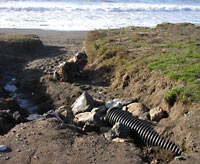|
|
|
|
|||||||||||||||||||||
|
What’s more exciting
for a surfer than having your boss ask you to surf as part of your
job? That's the situation I found myself in as the Exploratorium
geared up to add information about science and surfing to its Web
site. I needed to coordinate my surf date with a photographer, producer,
and videographer. As we got our calendars out to plan,
I realized that setting a date to surf isn’t always straightforward.
Seemingly, all I had to do was pick a day that worked for everyone, but it was more complicated than that. Of course I had to consider tides, waves, and weather. But I also had to consider what the weather had been like in previous days.
Planning for the tide
was simple: I was looking for low tide, as the surf area we had
picked for our shoot usually breaks better on a low tide (for more
on how tides work and why they’re important for surfers, check
out our
Dance of the Tides
article). I
consulted my Tidelog (a book that shows the height of the tide,
graphically, for every day of the year) to find a low tide in the
middle of the day at our chosen beach near Santa Cruz (you can also
find on-line tidal information for anywhere in the United States
at the
Saltwater
Tides Web site
).
We could see from our surf forecast that we would likely find decent waves on Sunday, but by Tuesday, the fun would probably be over. With no swell on Tuesday and rain predicted for Wednesday, we decided to change the date to Friday, with the caveat that we might have to cancel if it continued to rain on Thursday. If we’re planning to surf Friday, why should we care if it rains on Thursday? A look at what happens to ocean water during a storm might shed some light. The Drain from Rain Falls Mainly into the Nearby Ocean In urban and suburban communities, rain runs off impervious surfaces (which include rooftops, sidewalks, driveways, parking lots, playgrounds, streets, and highways). As runoff moves toward storm drains, it picks up oil, garden and household chemicals, animal waste, bird waste, litter, settled particulate matter, and other pollutants. More densely populated areas usually have more impervious surfaces, which results in more runoff.
In some communities, runoff in storm drains is partially cleaned up at water-treatment facilities, but often, it isn’t treated at all, to some extent because these facilities have limited capacity (it is also simpler and cheaper to just let the storm-drain water flow into the local watershed). So during and after a rainstorm, the runoff entering storm drains may be diverted directly into the ocean. When you see a storm drain with a sign that says, "Do not dump, flows to ocean" stenciled on it, it’s a pretty good bet that the water won’t be treated. This untreated runoff is the most common type of non-point source pollution (pollution that originates from many different sources rather than one specific, identifiable source) in our bays and oceans, and it presents a worldwide coastal-pollution problem.
Non-point
source pollution from motor vehicles and roadways may be the greatest
threat to the San Francisco Bay Area’s water quality. Copper
from brake pads, cadmium from tires, oil and grease from engines,
and other fine particulates enter Bay Area streams, the San Francisco
Bay, and the ocean via surface-water runoff. Paved surfaces that
prevent rainwater and other runoff from filtering through the ground
increase the amount of urban pollutants entering watersheds and
waterways. To find out more about the non-point source pollution,
see the
Surfrider
Foundation's Environmental index
.
Waiting
for a Healthy Wave
|
|
||||||||||||||||||||||
|
copyright Exploratorium |
|||||||||||||||||||||||




